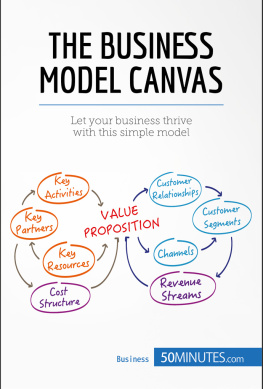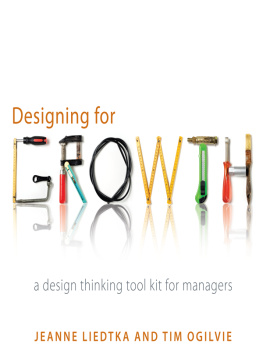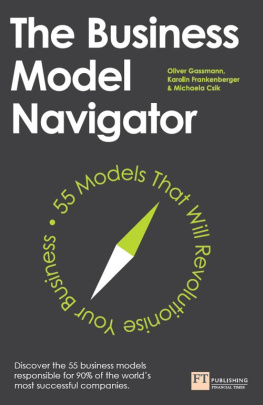DESIGN YOUR BUSINESS MODEL
A must for startups
ABHIRAM T.
TABLE OF CONTENT
PREFACE
Being valuable is the most important ingredient of any writing work .
U nless a book is valuable to the reader, it is useless. It does not matter how persuasive it is, how organized the contents are or how clear the word conveys the ideas. This book is particularly useful for all those people who are somehow connected with business or want to know how a business model works.
This book is about business model design. It explains all the components of the business model, whether a startup or a large organization. Once an organization grows, it becomes more complicated but the core of all the businesses carries the same kind of nucleus which carries the same type of components.
Traditionally we believe, there are no free lunches in business. If a business is making your life easier, they will charge a fee for that. Have you ever surprised how some companies are giving you great value, without charging any fee? For example, a search engine helps you find any piece of information, without charging you. Of course, you pay for the internet, but not for the search engine. The money you pay for internet data is not going to search engine companies. These search engine companies are having an army of computer programmers to write programs and algorithm, to make the search very fast and most relevant. In doing so they are having a huge cost. They are paying millions of dollars as salary to their employees, they maintain a huge infrastructure. Is not it a magic, they have such a huge cost to help us search efficiently and they are not charging us a penny? How many times have you wondered how does search engine make money when it doesnt charge even a penny? This is a magic of the Business Model.
Theres a famous quote related to this digitized world.
If you arent paying for it, youre the product
This is the case with search engines, you help it make money by attracting advertisers. Their innovative business model makes revenue from advertiser rather than users and these companies are very successful in business.
Some businessman complains saying, how these e-commerce companies can sell products at such a low cost. Their finished product selling cost is even lower than the raw material cost of a common businessman. Again, this magic relates to the business model. They took advantage of economies of scale. They innovated a complete supply chain, including no big inventory, no physical infrastructure, no floor managers so and so.
There are many such examples of business models, evolving day by day.
In a business model, you have some building blocks which are basic to all the business. You can play with them, innovate the interconnection of those building blocks. Do the experiments on those building blocks. You can disrupt the industry by working on your business model. You can diagnose the situation by comparing the business model of yours and your competitors business model.
If you dont improve the way you doing business, your competitors will eat you soon. Now the question is how to improve continuously? If you are working on a product only, after some years it's very difficult to improve it when it is already refined. In a business model, you have many ingredients to work on. You can also work on the integration of different sets of some of the ingredients. You can also improve the integration of all of these ingredients. Here you have a lot of combinations to play with and improve on those things. I have put some case studies in this book. You will see in our case studies ; just a tweak in the business model can make your profit double or triple. This book is also worth reading for those who want to understand how business works in a logical sense.
I extend my gratitude to my family, friends and all those people who supported me throughout this writing work. Especially to my wife - Preeti . This book is also inspired by available information in public domain and other written work on business topics. Many examples, stories, anecdotes are the result of a collection from various sources, such as newspapers, magazines, blogs over the last 10 years. Unfortunately, sources were not always noted or available; hence it became impractical to provide wish to express my gratitude to those who may have contributed to this work, even though anonymously.
CHAPTER 1
TRUST
Trust is the most important thing in any relationship.
T rustworthiness is the reciprocal belief that another person will consider how his/her intentions and behaviors affect you. In the business world, Brand is now more important than ever. But what do we mean by BRAND? It is nothing but trust. Especially when it comes to relationships with clients, customers, employees and all stakeholders in your business. Having trust in someone is putting yourself vulnerable to someone, believing that assured reliance on the integrity of character, ability, strength or truth of someone or something . Trust is a strategically critical issue in any type of relationship because a relationship without trust is not a relationship at all. Over the long term, business success is dependent upon a network of positive relationships.
Trust is a key component of our social life. Our economy works because people trust each other and the businesses they support. Trust is the natural result of thousands of tiny actions, words, thoughts, and intentions. Trust does not happen all at once; gaining trust takes time. It might take years of calling on a certain client to breakthrough and fully gain their comfort and trust.
Yet despite the importance of trust in the business world today, only few leaders have given it the focus and nurturing it deserves. Lack of trust causes a stressful, divisive atmosphere in a company. Trust is a non-negotiable aspect of a high-performing team, raising this awareness is only the starting point to building and sustaining trust. People who are supposed to be working together as a team need the team to truly function as suchnot just in name, but also in spirit. To help team members connect on a human level and to forge supportive, meaningful relationships that produce results. That takes trust. Trust in one another . One can argue that the sole purpose of marketing and communications is to earn and nurture trust.
To build team trust, people need to understand how trust works in teamsand to extend compassion to the
complexities and challenges that naturally come with it. They need to know where trust stands in their team, and be prepared to embrace opportunities to learn, grow and develop and to live the conviction trust-building takes. And they need to be prepared to rebuild trust whennot ifit gets compromised.
Business strategists have developed a system with which they teach leaders, how to build the Eight Pillars of Trust:
- Clarity People trust the clear and mistrust the ambiguous
- Compassion People put faith in those who care beyond themselves
- Character People notice those who do what is right over what is easy
- Competency People have confidence in those who are capable, confident and competent.
- Commitment People believe in those who stand through adversity
- Connection People want to work with, do business and be around friends
- Contribution People immediately respond to results
- Consistency People trust consistency over the time in the little things done.
The clarity in communication is important for making an impact. The clarity in job role improves the performance of employee on job. Clarity is also linked with rational. When someone sees clarity in something, he looks at it as a logical observer and he finds it aligned with his logical sense and belief. Sometimes we just "cannot understand" each other because we are too different in our perspectives, goals, experiences, and skills. Hence clarity also depends on how familiar it is for that person. It is often seen that the common ground used to connect people faster than anything. Speaking the same language, sharing the same social background are some examples for the same.








